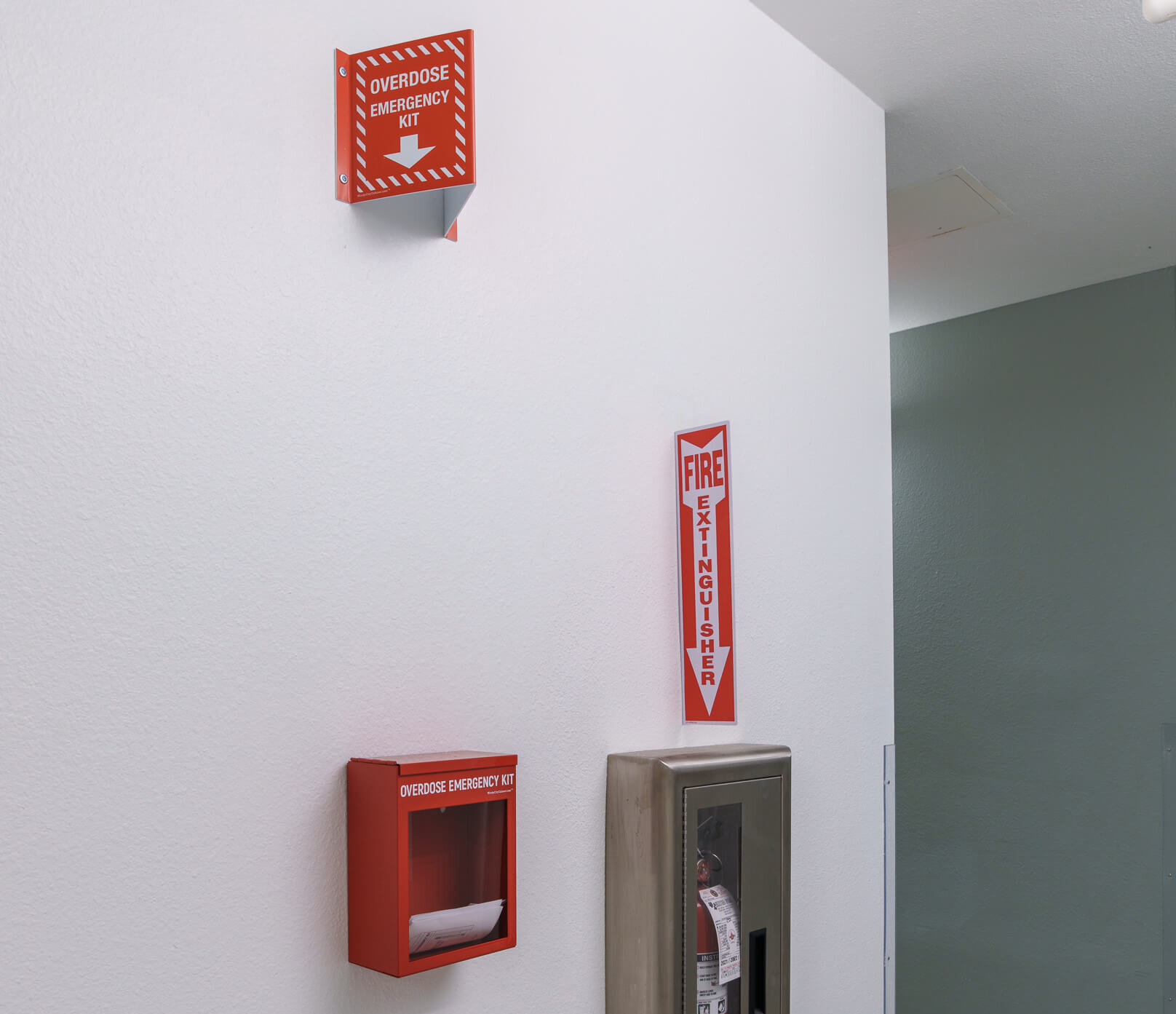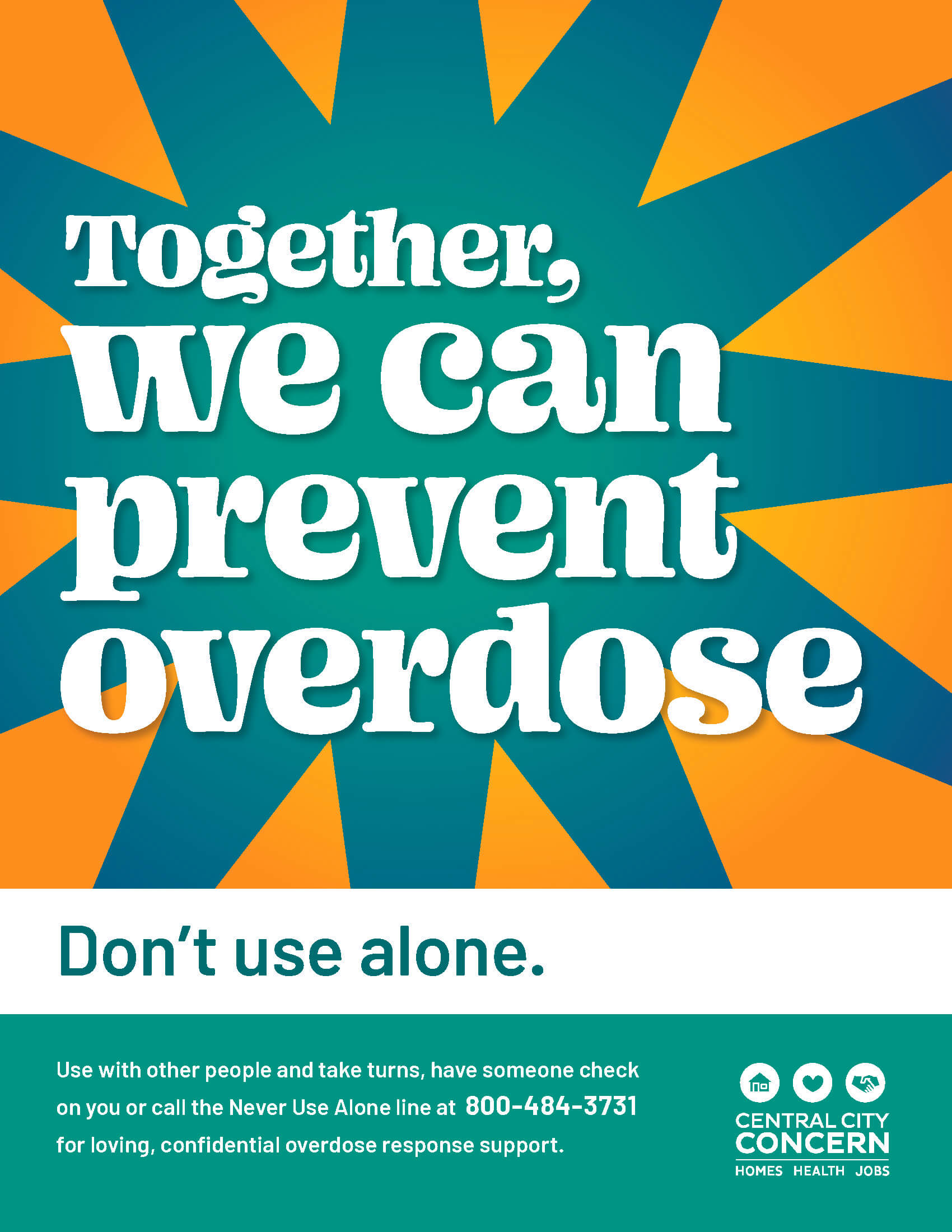back to all blog posts
This Overdose Awareness Day, We’re Working Toward Zero
Tuesday, August 29, 2023August 31 marks International Overdose Awareness Day (IOAD), a day to remember those who have died from overdose, acknowledge the grief of the people left behind and to continue the work to end overdose in our communities.
Overdose is a devastating reality for many CCC employees and clients.
Many have lost friends and family to overdose. Our residents have lost neighbors. Our staff have lost clients. Many of us have survived overdose.
We mourn the people we’ve lost. We’re full of gratitude for those who survived and are still with us today—some of whom are now using their lived experience to help others.
Ending Overdose
Tragically, overdoses have skyrocketed in Oregon in recent years. Nearly twice as many people died from drug overdoses in Oregon in 2022 than in 2019.
CCC’s clients and residents are profoundly affected by this trend. In 2022, we saw a significant increase in overdose deaths, as well as an increase in nonfatal overdoses. The increase is in part due to an increase in the synthetic opioid fentanyl and fentanyl analogues in our drug supply—an opioid that is 30 to 50 times more potent than heroin. Additionally, we are also seeing increased overdoses related to the combined use of stimulants like methamphetamine with opioids.
Pat, who has lived in CCC housing for over two years, has witnessed the overdose crisis firsthand. “It demoralizes everyone to lose people,” he said. “Having something to help keep people here is a really good idea.”
In response, CCC launched the Zero Overdose Initiative, with a vision of ending overdose deaths among our clients. We’re increasing access to naloxone (also known as Narcan), educating housing residents about overdose prevention, working directly with residents at high risk of overdose and, in some cases, distributing sterile harm reduction supplies.
The Initiative has been made possible by funding from CareOregon.
“Our Zero Overdose Initiative is about saving lives and second chances,” said President and CEO Andy Mendenhall, M.D. “Recovery isn’t always linear, and we believe in progress, not perfection. Everyone struggling with a substance use disorder deserves the opportunity to survive overdose so they can get back on track in their recovery.” Since implementing the Zero Overdose Initiative, CCC has seen a decrease in overdose deaths in our housing. Zero Overdose is a lofty goal. We’ll keep working until we get there.
CCC Overdose Prevention Manager Juliana DePietro, is excited to take on the challenge. “I’m grateful to see an agency I care about so much embracing the widest possible spectrum of interventions for people,” she said. Harm reduction interventions can provide people with space and clarity so they can make decisions with the widest range of knowledge and information about the consequences of their drug use.”
 CCC Overdose Prevention Manager Juliana DePietro in Old Town.
CCC Overdose Prevention Manager Juliana DePietro in Old Town.
Reducing Harm and Saving Lives
The Zero Overdose Initiative utilizes the principles of harm reduction, which includes strategies and ideas intended to reduce the negative consequences associated with drug use. Though harm reduction and abstinence-based strategies and services are sometimes viewed as opposites or even in conflict with one another, they are part of the same continuum of care and support for people who use drugs. Harm reduction practices are crucial to CCC’s goal of ending fatal overdoses among our clients and residents.
The harm reduction strategies we use at CCC focus on ways to build trust and relationships with people who use drugs so they can identify what tools they need to use more safely and what goals they have for their use, including accessing withdrawal management (also called detox) and abstinence-based treatment. And while the concept can be controversial, there is no evidence that harm reduction strategies encourage drug use.
CCC Hepatitis C Program Coordinator Olivia Hnilicka has been in recovery for three years and has both personal experience with using harm reduction services while in active addiction and professional experience working in the harm reduction field.
“Harm reduction services and tools work as a tool of engagement,” she said. “I’m a product of that. When I was in my active addiction, I had such a distrust of all people and systems. It took finding people and organizations that I did trust for me to take steps toward healthier choices and a safer lifestyle.”
She believes her journey would have looked very different if she had not found harm reduction services. “The stability and the connection that harm reduction gave me led me to look at my choices and look at the way that my active drug use was affecting my life, which then opened the door to the 12 Step recovery programs I’m now a part of.”
The Steps to Zero Overdose
The Zero Overdose Initiative has evolved over time to adapt to the needs of our community. To date, our accomplishments include:
Increasing naloxone access
Naloxone is now easily accessible in a clearly marked box on every floor of every housing building with common spaces at CCC. In the small number of buildings that do not have common spaces, it’s available in another central location.
 Naloxone station in CCC housing.
Naloxone station in CCC housing.
Training staff in naloxone administration
Many staff across CCC have received the opportunity to receive training on the proper administration of naloxone, including how to recognize an overdose. This includes Clean Start staff, who are able to respond to overdoses while working in the community.
Employees learning about how to respond for the first time have found it “extremely helpful,” said Juliana. “It feels empowering. And when I follow up with folks after they respond to an overdose, some have told me that they were grateful that they had the training so they could use it.”
 CCC staff after our first in-person naloxone training.
CCC staff after our first in-person naloxone training.
Educating residents about overdose prevention
CCC’s Tenant Advisory Committee advised CCC staff on the best ways to reach residents with information about overdose prevention. Posters are now on display at every housing building with useful information, encouraging people to never use alone, take it slow and test the strength of their drugs, have naloxone ready and talk to CCC staff about ways to prevent overdose.
 An example of posters are on display in CCC housing.
An example of posters are on display in CCC housing.
A clinical coordination intervention for housing residents at high risk of overdose
CCC’s Overdose Prevention and Aftercare (OPA) program has been launched as a pilot at five CCC housing sites. If a CCC employee believes a resident may be at risk of overdose, they’re able to refer that resident to CCC’s OPA team whose goal is to make contact with the resident in 1-2 days. An Overdose Prevention & Aftercare Specialist (OPAS) then will assess their basic needs, offer harm reduction guidance around their use, ensure they have naloxone and work to connect them to longer-term and holistic care.
 Manager of Mental Health Integrated Housing Services Gordon Keepers (left) and Overdose Prevention Manager Juliana DePietro.
Manager of Mental Health Integrated Housing Services Gordon Keepers (left) and Overdose Prevention Manager Juliana DePietro.
Distribution of harm reduction supplies
Some CCC supportive housing and health services programs distribute supplies that support safer drug use, an evidence-based public health intervention with the goal of saving lives and reducing harms associated with substance use. For example, safe injection and safe smoking kits can be offered on a case-by-case basis to residents in non-alcohol-and-drug-free buildings when they are known to use or have recently returned to use. They can also be distributed when residents of alcohol-and-drug-free buildings exit a program early.
In addition to being an engagement opportunity, sterile supplies help to reduce infectious related complications of drug use. For example, safe injection kits include alcohol prep pads, because cleaning the site of the injection can prevent infection. Safe smoking kits include sterile mouthpieces to reduce risks of burning the mouths or tongue which can lead to wounds that increase risk of infection, including hepatitis C. “We provide all of these supplies to reduce infection transmission among people who use drugs, and also to show them and their health and their lives matter to us,” said Juliana.
 CCC staff assembling kits.
CCC staff assembling kits.
This content block does not have a preview.
What You Can Do
1. Don’t stigmatize people who use drugs.
“We need to really frame any conversations we have about overdose and about drug use in our community from a people centered perspective,” said Juliana. Research demonstrates stigma damages the health and well-being of people with substance use disorders and may make them less likely to seek care. Don’t use dehumanizing language and remind people in your community that people who use drugs are people.
2. Carry naloxone and learn how to use it.
Naloxone reverses overdoses and is safe, easy to get and easy to use. You can get a dose of naloxone to carry from your local pharmacy directly, with or without a prescription. You can learn more about how to recognize an overdose and respond from the National Harm Reduction Coalition. It is especially important to get naloxone into the hands of people who use drugs, because they are the community members most likely to reverse an overdose.
3. Look out for your community.
Share these tips with people in your life who use drugs.
- Never use alone. If you can, use with other people. Take turns using so that someone can always administer naloxone if needed.
- If you can’t use with others, let a trusted person know that you’re using so someone can check on you. You can also call the Never Use Alone line at 800-484-3731 for 24/7 loving, confidential overdose response support.
- Take it easy. Go slow and use less at first to test the strength of your drugs.
- Always have naloxone available.